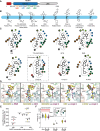Navigating from cellular phenotypic screen to clinical candidate: selective targeting of the NLRP3 inflammasome
- PMID: 39653810
- PMCID: PMC11730736
- DOI: 10.1038/s44321-024-00181-4
Navigating from cellular phenotypic screen to clinical candidate: selective targeting of the NLRP3 inflammasome
Abstract
The NLRP3 inflammasome plays a pivotal role in host defense and drives inflammation against microbial threats, crystals, and danger-associated molecular patterns (DAMPs). Dysregulation of NLRP3 activity is associated with various human diseases, making it an attractive therapeutic target. Patients with NLRP3 mutations suffer from Cryopyrin-Associated Periodic Syndrome (CAPS) emphasizing the clinical significance of modulating NLRP3. In this study, we present the identification of a novel chemical class exhibiting selective and potent inhibition of the NLRP3 inflammasome. Through a comprehensive structure-activity relationship (SAR) campaign, we optimized the lead molecule, compound A, for in vivo applications. Extensive in vitro and in vivo characterization of compound A confirmed the high selectivity and potency positioning compound A as a promising clinical candidate for diseases associated with aberrant NLRP3 activity. This research contributes to the ongoing efforts in developing targeted therapies for conditions involving NLRP3-mediated inflammation, opening avenues for further preclinical and clinical investigations.
Keywords: Clinical Candidate; IL-1β; Inflammasome; NLRP3; Novel Inhibitor.
© 2024. The Author(s).
Conflict of interest statement
Disclosure and competing interests statement. All authors are (or were) J&J employees when participating in this work and declare no competing interests.
Figures










References
-
- Bauernfeind FG, Horvath G, Stutz A, Alnemri ES, MacDonald K, Speert D, Fernandes-Alnemri T, Wu J, Monks BG, Fitzgerald KA et al (2009) Cutting edge: NF-kappaB activating pattern recognition and cytokine receptors license NLRP3 inflammasome activation by regulating NLRP3 expression. J Immunol 183:787–791 - PMC - PubMed
-
- Boyden ED, Dietrich WF (2006) Nalp1b controls mouse macrophage susceptibility to anthrax lethal toxin. Nat Genet 38:240–244 - PubMed
MeSH terms
Substances
LinkOut - more resources
Full Text Sources
Molecular Biology Databases
Miscellaneous

